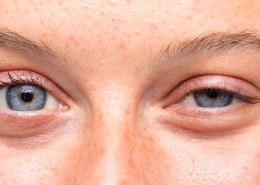The pic not me I took from Google. I look something like that now. last yr I was in a minor car accident and had some nerve damage to my left eye. after that my left eyelid start to droop because ...
Eyelid twitching, also known as myokymia, is a common and usually benign condition characterized by involuntary, repetitive spasms of the eyelid muscles. While it can be annoying, it is typically not a sign of a serious medical issue. Here are some potential causes and considerations: 1. Stress andRead more
Eyelid twitching, also known as myokymia, is a common and usually benign condition characterized by involuntary, repetitive spasms of the eyelid muscles. While it can be annoying, it is typically not a sign of a serious medical issue. Here are some potential causes and considerations:
1. Stress and Fatigue: Stress is one of the most common triggers for eyelid twitching. Similarly, lack of sleep or fatigue can exacerbate the condition. Ensuring adequate rest and managing stress through relaxation techniques or exercise may help alleviate symptoms.
2. Caffeine and Alcohol: Excessive consumption of caffeine or alcohol can lead to muscle spasms, including eyelid twitching. Reducing intake of these substances might help reduce the frequency of twitching.
3. Eye Strain: Prolonged use of digital devices or reading without breaks can cause eye strain, leading to twitching. Practicing the 20-20-20 rule (every 20 minutes, look at something 20 feet away for 20 seconds) can help reduce eye strain.
4. Dry Eyes: Dryness of the eyes can irritate the eyelid muscles, causing twitching. This is more common in individuals who use contact lenses or spend a lot of time in front of screens. Using lubricating eye drops may provide relief.
5. Nutritional Imbalances: Deficiencies in certain nutrients, such as magnesium, can contribute to muscle spasms. Ensuring a balanced diet with adequate vitamins and minerals is important.
6. Allergies: Allergies can cause irritation and twitching of the eyelids. If you have known allergies, managing them with antihistamines or other treatments may help.
7. Medications: Some medications can cause muscle twitching as a side effect. If you suspect this might be the case, consult with your healthcare provider.
8. Neurological Causes: In rare cases, persistent eyelid twitching can be a sign of a more serious neurological condition, such as blepharospasm or hemifacial spasm. If the twitching persists for several weeks, affects other parts of your face, or is accompanied by other symptoms, it is advisable to seek medical evaluation.
Practical Advice:
– Try to identify and reduce potential triggers, such as stress or caffeine.
– Ensure you are getting enough sleep and taking regular breaks from screens.
– Consider using lubricating eye drops if you experience dry eyes.
– Maintain a balanced diet and consider a multivitamin if dietary intake is insufficient.
If the twitching persists or worsens, or if you experience additional symptoms, it would be wise to consult a healthcare professional for further evaluation and management.
See less

Hello! I'm Dr Petrina, Senior Consultant Opthalmologist at Eagle Aesthetics & Surgery. I specialise in Oculofacial Plastic Surgery (which includes droopy eyelid surgery) The muscle that helps us to open our eyelids is called the levator muscle. This muscle is supplied by a nerve and this may beRead more
Hello! I’m Dr Petrina, Senior Consultant Opthalmologist at Eagle Aesthetics & Surgery. I specialise in Oculofacial Plastic Surgery (which includes droopy eyelid surgery)
The muscle that helps us to open our eyelids is called the levator muscle. This muscle is supplied by a nerve and this may be the nerve that has been injured in the car accident. Due to this, the muscle does not work so well . However with time, the disuse of the levator muscle has also caused it to weaken further thus causing more of the eyelid droop.
Eyelid surgery to correct droopy eyelids is very manageable. To calm patients’ anxiety, we can have our anaesthetist to give some sedation at the start of the surgery . We will then do a small injection of local anaesthetic (but you won’t feel it at all because youre sedated) and we start the eyelid surgery. Your eyes are closed so you won’t be seeing any part of the surgery. After about 40 minutes, we will wake you up gently and ask that you help us open your eyes so that we can check that both eyes are symmetrical. Once we are happy with the results of the eyelid surgery, our anaesthetist will let you go back to your sleep and we close up the eyelid wound to complete the procedure.
If you have any concerns about the procedure, feel free to reach out for more information. Happy to help answer any more questions!
Dr Petrina Tan
Senior Consultant Opthalmologist
Eagle Aesthetics & Surgery
Instagram: @drpetrina_eyedoc
The information provided on this forum is for educational purposes only and not intended as medical advice. Please consult a healthcare provider for any medical concerns, diagnosis or treatment.
See less